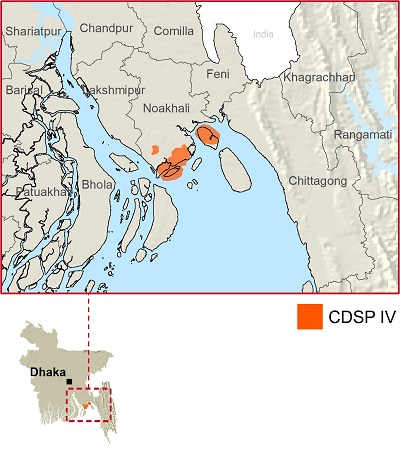Char Development and Settlement Project IV
IFAD Asset Request Portlet
ناشر الأصول
Char Development and Settlement Project IV
The project is designed to develop improved and more secure livelihoods for poor people living on newly accreted coastal islands known locally as chars. It adopts an integrated approach to coastal zone development that will:
- Support water resource management on three of the five chars to protect land from tidal and storm surges
- Improve drainage and enhance land accretion
- Finance climate-resilient infrastructure for communications
- Improve access to markets, potable water and sanitation in all five chars
- Help 20,000 households obtain secure land titles
- Provide technical assistance to teach farmers to make better use of land resources
- Establish a team to disseminate lessons in coastal zone development and plan the future development of new chars.
Additional support will be provided to the most disadvantaged members of the community, including landless households and women, who will be particularly targeted in NGO activities and labour contracting.

تقارير الرئيس
تقرير تصميم المشروعات
وثائق دعم الإشراف والتنفيذ
وثائق دعم الإشراف والتنفيذ
Supervision mission, March 2017
Supervision mission, March 2016
Supervision mission, April 2014
Follow up mission report, September 2013
Supervision mission, March 2013
الاسيت ببليشر
الاسيت ببليشر
الاسيت ببليشر
الاسيت ببليشر
الاسيت ببليشر
Mid-Term Review Report, May 2015
الاسيت ببليشر
الاسيت ببليشر
الاسيت ببليشر
الاسيت ببليشر
الاسيت ببليشر
الاسيت ببليشر
الاسيت ببليشر
2023-Ministry of Finance-AUDIT_REPORT
2022-Ministry of Finance-AUDIT_REPORT
2021-Ministry of Finance-AUDIT_REPORT
الاسيت ببليشر
الاسيت ببليشر
Related Contents
Related Contents
القوة الرائعة للأراضي الرطبة
ترتبط الأراضي الرطبة، مثل المستنقعات والسبخات ومصبات الأنهار، ارتباطا وثيقا برفاهيتنا. فهذه المناطق المشبعة بالمياه هي بؤر ساخنة للتنوع البيولوجي، وموطن لعدد لا يُحصى من النباتات والميكروبات. وهي جزء أساسي من دورات المياه الطبيعية، وبالتالي فهي ضرورية لجودة المياه والحماية من الفيضانات والتآكل.
دعونا نزور بعض هذه النظم الإيكولوجية - ونلتقي بالسكان الريفيين الذين يحمونها.